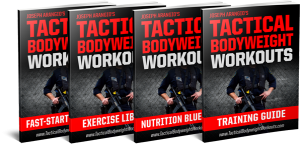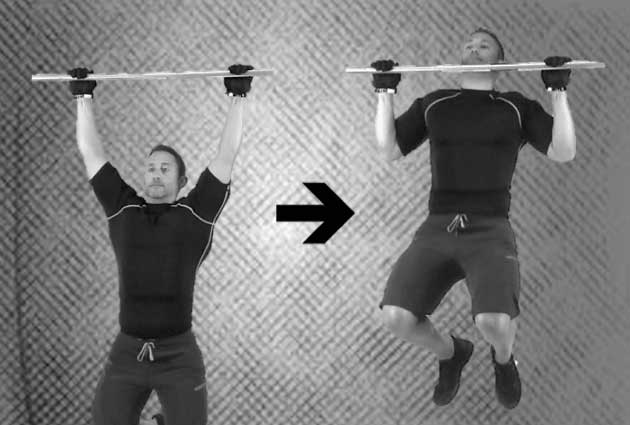The old-school pullup is possibly the second-greatest exercise of all time (squats are king).
Pullups strengthen your lats, upper back, and core. They’re way better than an arm curl if you want bigger biceps. Plus they do a great job of measuring how strong you are relative to your body weight. This fact alone makes pullups a staple of all tactical performance testing.
You’re not a true tactical athlete unless you can do at least 10 dead-hang pullups with your bodyweight. Elite tactical operators perform 20 non-kipping pullups while wearing a 40-pound vest.
When it comes to this classic pulling exercise, you probably fall into one of three categories:
1. You can’t do a pullup
2. You want to do more pullups
3. You want to do weighted pullups
No matter what your goal is, I’ve created a training program to help you master this upper-body move.
GOAL: Do at least one pullup
PLAN: Grab a strong elastic band and loop one end around a sturdy bar. The other end of the band goes over your bent knee. Start out with a band that allows you to do at least five perfect reps. No kipping or swinging or bouncing allowed. When you can do 10 reps, with excellent technique, use a lighter band.
If you don’t have a big rubber band, just do isometric-eccentric pullups (aka “squeeze-negative” pullups). To do this, grab a bar with your palms facing away and jump up so your chest touches it. As an alternate you can place a box or chair under the bar so you don’t have to jump.
Hold this chest-to-bar position for three seconds and tense your upper back, like your muscles are a sponge and you’re trying to squeeze water out of the sponge.
Next, take three seconds to lower yourself back down (the “negative”). If you suck at this, just focus on the squeeze part. Once you can do 10 perfect squeeze-negative pullups, you’re ready to do at least one standard pullup.
GOAL: Do more pullups
PLAN: Test yourself out to see how many perfect non-kipping pullups you can do. Write down your maximum pullups and then divide by two. This is your ½ Max.
In the following 4-week workout, you’ll slowly add five pounds each week by gripping a dumbbell between your knees. You can also drop a weight plate in your tactical plate carrier or wear weighted compression apparel. Do this training program twice per week, with 48-72 hours between workouts.
Week 1 – 3 sets x ½ Max + 5 lbs
Week 2 – 4 sets x ½ Max + 10 lbs
Week 3 – 4 sets x ½ Max + 15 lbs
Week 4 – 2 sets x ½ Max + 20 lbs
On Week 5, retest your max pullups and then repeat the program.
GOAL: Do weighted pullups
PLAN: You’ll follow a ladder system to prep your muscles to handle the demands of pulling yourself up and over a wall while wearing your kit. This loading technique reduces fatigue yet allows you to handle a ton of volume. Pick a weight that lets you do five pullups with excellent technique. Once again, you can use a dumbbell or a weight vest or whatever you have available.
Each week you’ll perform the ladder like this: Do one rep, rest 20 seconds, then do two reps, rest 20 seconds again, do three reps, and rest again, etc. When you get to the end of the ladder, rest for 60 seconds. That is one set.
Week 1 – 3 sets x 1, 2, 3, 4 + weight vest
Week 2 – 3 sets x 1, 2, 3, 4, 5 + weight vest
Week 3 – 4 sets x 1, 2, 3, 4, 5 + weight vest
Week 4 – 2 sets x 1, 2, 3, 4, 5 + weight vest
Increase the weight by five pounds if you complete all of the recommended reps with great form. Do these workouts twice per week, with 48-72 hours between sessions.
Starting Position: Grasp an overhead bar or handles using an overhand grip (palms facing away from you). Draw your belly button in and tense your abdomen. Perform a Kegel contraction (tighten the muscles you’d use to stop the flow of urine; hold). Hang with your arms almost completely extended. Keep your knees slightly bent, with your legs crossed at your ankles. Hold your body in a straight line, from your ears to your knees. Technique: Begin the movement by pulling your shoulder blades back and down. Lift your body up, continuing to pull with your upper back until your chin is over the bar. Finish the pull with your lats until your elbows are flexed to 90 degrees. Hold and slowly lower. Repeat for the recommended number of repetitions. Coaching Tips: At the end of each rep, make sure you lower yourself down until your arms are almost fully extended. If you have shoulder or wrist pain, use a neutral grip (palms facing each other).How to Do a Perfect Pullup
Remember not to go past technical failure. In other words, when your form starts to break down the set is over. If you want to increase your pullups, keep your form tight.
 Joseph Arangio, MS, CSCS, is a tactical strength and conditioning coach and author of Tactical Bodyweight Workouts.
Joseph Arangio, MS, CSCS, is a tactical strength and conditioning coach and author of Tactical Bodyweight Workouts.
